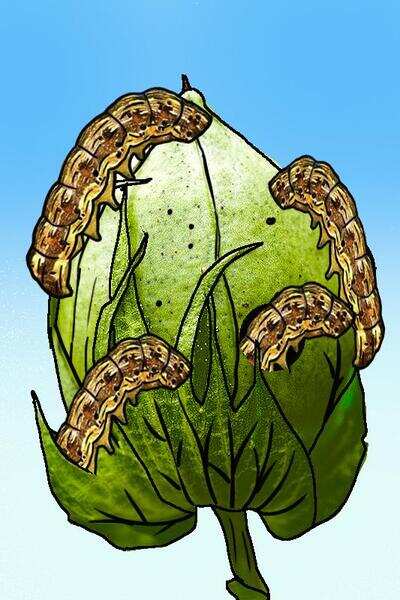
Nagpur: The Indian Council of Agricultural Research-Central Institute for Cotton Research (CICR) has claimed that the pink bollworm infestation had reduced by 70% in the last cropping season (2018-19) in all the cotton growing districts pan India due to implementation of CICR strategies for prevention and control of the infestation.
This year too, CICR plans to combat the pink bollworm attack by following previous year’s management practices. The institute will be holding a national-level meeting on May 17 in this regard.
Pink bollworm had taken massive toll of the cotton crop in the 2017-18 season. Excessive use of pesticides had led to deaths of about 45 farmers due to pesticide inhalation, forcing the state government to take preventive measures the next season.
CICR acting director VN Waghmare told TOI that during 2017-18 there was epidemic-level pink bollworm infestation in major cotton growing states of Maharashtra, Andhra Pradesh, Telangana, Karnataka and Madhya Pradesh. The infestation ranged between 8% to 92% with corresponding yield losses of 10-30%.
“ICAR-CICR played a pivotal role in devising and disseminating the prevention and control strategies through involvement of all stakeholders like state agriculture department (SAD), state agriculture university (SAU), krishi vigyan kendras (KVKs), seed and pesticide producing companies, use of pheromone traps, NGOs and media. Yet, certain international experts had stated that the pink bollworm was out of control in India. This is false,” said Waghmare.
Last year, under a project of the Union agriculture department, CICR surveyed 21 major cotton growing districts in seven states. The survey covered 50 acres per district reaching 1,050 farmers. Five villages, with 10 farmers in each, were surveyed in every district.
As the survey reports, pink bollworm infestation per acre had reduced from 20-90% in 2017-18 to 2.8-48% in 2018-19 in Maharashtra, from 0-44% in 2017-18 to 5-15% in 2018-19 in Gujarat, from 38% in 2017-18 to 5-35% in 2018-19 in Madhya Pradesh, 24-92% in 2017-18 to 5-20% in 2018-19 in Telangana, 8-92% in 2017-18 to 5-57% in 2018-19 in Andhra Pradesh. However, in Tamil Nadu the infestation increased from 1-5 to 7-20% and in Haryana from nil to 5-35%.
The director said that in India single gene Bt cotton (Cry1AC) or bollgard was introduced in 2002. Later, two genes were introduced (Cry1Ac+Cry 2Ab) or Bollgard II in 2006. Currently, the area under Bt cotton is about 88% and Bollgard II covers the entire area. Until 2009, the three bollworms in Bt cotton — the American, Spotted and Pink Bollworm — were under check.
VL Nagrare, principal scientist (crop protection), said the first report of resistance to pink bollworm (bollgard) came in 2010 and the bollgard II was reported in 2014. In 2015, pink bollworm severely impacted cotton production in Gujarat but in subsequent years the state managed it with concreted efforts from the government and all stakeholders.
Until past decade, no incidence of pink bollworm was reported in north Indian states (Punjab, Haryana and Rajasthan). But in 2018-19, these states too recorded an infestation of above Economic Threshold Level on BGII near ginneries in Jind district in Haryana, warranting vigilance there too.
Head: Strategies to be followed
1. CICR and SAUs
· Monitoring for insect resistance to cry toxins and insecticides
· SAUs to survey villages to identify high productive short duration Bt hybrids preferably tolerant to sap sucking insect pests
· Planting Bt and non By hybrids on research farms for regular pest monitoring
· Training for mass production of parasitoids and bio-pesticides
· Issuing weekly advisories.
· Front-line demonstrations on eco-practices for effective pest management
· Field experiments on short duration (150-160days) varieties in high density planting under non-pesticide pest management
2. State Agriculture Department
· Farmers to be told to cultivate short duration high productive hybrids that would escape pink bollworm attack
· From August, installing pink bollworm pheromone traps@5 traps per hectare
· Farmers to be told to remove rosette flowers
· Farmers to be advised to use chemicals only after pest crosses economic threshold value
· Suggest spray of Chlorpyrifos or Quinalphos or Thiodicarb during mid-September to October and use of any synthetic pyrethroid in November. Insecticide sprays in November-December may be taken up only in fields having at least 8-10 green bolls per plant, generally in irrigated cotton
· Recommend termination of cotton crop by December/mid Jan in central zone states
· Advise composting of cotton stalk
· Strictly discourage mixing of pesticides
· Restrict cotton seed sale to only right sowing period
3. National Agriculture Department
· Permit ‘refuge-in-bag’ (RIB) with 95:5 ratio of Bt and non Bt seeds
4. Seed companies
· Promote short duration varieties and hybrids
· Discontinue sale of long duration hybrids
· Ensure RIB is followed
5. Farmers
· Terminate crop by December and mid January in central and south India
· Use only authentic seeds
· Synchronous sowing with early maturing varieties
· Install pheromone traps
· Inspect crop at squaring and flowering stage for PBW larvae
· Strictly avoid spraying of pyrethroids before November and use of any insecticide mixtures and never use tank mixtures
· Do not store infested cotton stalks
6. Ginneries and market yard
· Maintain cleanliness around ginneries and install pheromone traps at all market yards and ginneries
· Destroy all captured moths
This year too, CICR plans to combat the pink bollworm attack by following previous year’s management practices. The institute will be holding a national-level meeting on May 17 in this regard.
Pink bollworm had taken massive toll of the cotton crop in the 2017-18 season. Excessive use of pesticides had led to deaths of about 45 farmers due to pesticide inhalation, forcing the state government to take preventive measures the next season.
CICR acting director VN Waghmare told TOI that during 2017-18 there was epidemic-level pink bollworm infestation in major cotton growing states of Maharashtra, Andhra Pradesh, Telangana, Karnataka and Madhya Pradesh. The infestation ranged between 8% to 92% with corresponding yield losses of 10-30%.
“ICAR-CICR played a pivotal role in devising and disseminating the prevention and control strategies through involvement of all stakeholders like state agriculture department (SAD), state agriculture university (SAU), krishi vigyan kendras (KVKs), seed and pesticide producing companies, use of pheromone traps, NGOs and media. Yet, certain international experts had stated that the pink bollworm was out of control in India. This is false,” said Waghmare.
Last year, under a project of the Union agriculture department, CICR surveyed 21 major cotton growing districts in seven states. The survey covered 50 acres per district reaching 1,050 farmers. Five villages, with 10 farmers in each, were surveyed in every district.
As the survey reports, pink bollworm infestation per acre had reduced from 20-90% in 2017-18 to 2.8-48% in 2018-19 in Maharashtra, from 0-44% in 2017-18 to 5-15% in 2018-19 in Gujarat, from 38% in 2017-18 to 5-35% in 2018-19 in Madhya Pradesh, 24-92% in 2017-18 to 5-20% in 2018-19 in Telangana, 8-92% in 2017-18 to 5-57% in 2018-19 in Andhra Pradesh. However, in Tamil Nadu the infestation increased from 1-5 to 7-20% and in Haryana from nil to 5-35%.
The director said that in India single gene Bt cotton (Cry1AC) or bollgard was introduced in 2002. Later, two genes were introduced (Cry1Ac+Cry 2Ab) or Bollgard II in 2006. Currently, the area under Bt cotton is about 88% and Bollgard II covers the entire area. Until 2009, the three bollworms in Bt cotton — the American, Spotted and Pink Bollworm — were under check.
VL Nagrare, principal scientist (crop protection), said the first report of resistance to pink bollworm (bollgard) came in 2010 and the bollgard II was reported in 2014. In 2015, pink bollworm severely impacted cotton production in Gujarat but in subsequent years the state managed it with concreted efforts from the government and all stakeholders.
Until past decade, no incidence of pink bollworm was reported in north Indian states (Punjab, Haryana and Rajasthan). But in 2018-19, these states too recorded an infestation of above Economic Threshold Level on BGII near ginneries in Jind district in Haryana, warranting vigilance there too.
Head: Strategies to be followed
1. CICR and SAUs
· Monitoring for insect resistance to cry toxins and insecticides
· SAUs to survey villages to identify high productive short duration Bt hybrids preferably tolerant to sap sucking insect pests
· Planting Bt and non By hybrids on research farms for regular pest monitoring
· Training for mass production of parasitoids and bio-pesticides
· Issuing weekly advisories.
· Front-line demonstrations on eco-practices for effective pest management
· Field experiments on short duration (150-160days) varieties in high density planting under non-pesticide pest management
2. State Agriculture Department
· Farmers to be told to cultivate short duration high productive hybrids that would escape pink bollworm attack
· From August, installing pink bollworm pheromone traps@5 traps per hectare
· Farmers to be told to remove rosette flowers
· Farmers to be advised to use chemicals only after pest crosses economic threshold value
· Suggest spray of Chlorpyrifos or Quinalphos or Thiodicarb during mid-September to October and use of any synthetic pyrethroid in November. Insecticide sprays in November-December may be taken up only in fields having at least 8-10 green bolls per plant, generally in irrigated cotton
· Recommend termination of cotton crop by December/mid Jan in central zone states
· Advise composting of cotton stalk
· Strictly discourage mixing of pesticides
· Restrict cotton seed sale to only right sowing period
3. National Agriculture Department
· Permit ‘refuge-in-bag’ (RIB) with 95:5 ratio of Bt and non Bt seeds
4. Seed companies
· Promote short duration varieties and hybrids
· Discontinue sale of long duration hybrids
· Ensure RIB is followed
5. Farmers
· Terminate crop by December and mid January in central and south India
· Use only authentic seeds
· Synchronous sowing with early maturing varieties
· Install pheromone traps
· Inspect crop at squaring and flowering stage for PBW larvae
· Strictly avoid spraying of pyrethroids before November and use of any insecticide mixtures and never use tank mixtures
· Do not store infested cotton stalks
6. Ginneries and market yard
· Maintain cleanliness around ginneries and install pheromone traps at all market yards and ginneries
· Destroy all captured moths
Make sense of the 2019 Lok Sabha elections and results on May 23 with The Times of India. Follow TOI to track latest news, live updates, news analysis and cutting-edge data analytics. Track live election results, the big trends and fastest news updates from each of India's 543 Lok Sabha constituencies on the counting day with India's largest news network.
#ElectionsWithTimes
Quick Links
Lok Sabha Election Schedule 2019Lok Sabha Election NewsDelhi Capitals teamMI team 2019Rajasthan Royals 2019RCB team 2019Maharashtra Lok Sabha ConstituenciesBJP Candidate ListBJP List 2019 TamilnaduShiv Sena List 2019AP BJP List 2019Mamata BanerjeeBJP List 2019 MaharashtraPriyanka GandhiBJP List 2019 KarnatakaAMMK Candidate List 2019BJP List 2019 WBLok Sabha Elections in Tamil NaduBSP List 2019 UPNews in TamilLok Sabha Poll 2019Satta Matka 2018PM ModiMahagathbandhanNagpur BJP Candidate ListChandrababu NaiduTamil Nadu ElectionsUrmila MatondkarNews in TeluguMadras High CourtTejashwi YadavArvind KejriwalTejasvi SuryaPawan KalyanArvind KejriwalYogi AdityanathJaya PradaSatta King 2019Srinagar encounter
Get the app









